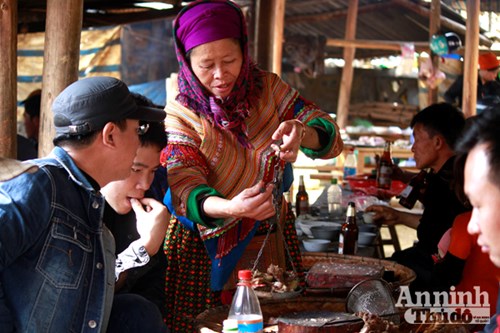Can Cau is very well known for its original character of local hill tribe people. It can be seen as one of the rare kinds of such market which still maintains its traditional cultural.
Located about 100 km northeast of Lao Cai city and 30 km north of Bac Ha town, Bac Ha district, Lao Cai province, Can Cau market which is famous for the originality and authenticity, was held on every Saturday in Can Cau village, Simacai district, Lao Cai province.
Can cau market is located beside road 153 - the unique road connecting Bac Ha town and Si Ma Cai town. This soil road has been widen and tarred over the last few years. Standing in the market, visitors can gaze with veneration at the golden terraced fields in the ripe season clinging to the mountainside as well as imposing mountains and hills that endlessly stretching of the North-western. Early in the morning of the fair day, groups of Hmong people, Giay people and Dao people from various villages gather in Can Cau village. They travel mainly by horses, motorbikes and bring textile products, agricultural products as well as cattle for trading.
The market is divided into various areas for every consumer goods including vegetables, agricultural products, cattle and colorful handmade textiles. Although there are various modern items such as fashion clothes and footwear can be found in the market, but the traditional character of a highland market is still maintained.
In Can Cau, the excited atmosphere as well as the original cultural of the highland fair is expressed much more clearly. Tourists will easily recognize that this place is not only a market for trading goods but also a wonderful place for friends to meet or for young people in beautiful costumes to seek for their “other half”.
When visiting Can Cau, tourists should not miss a chance to enjoy and explore several traditional dishes of local cuisine. Thang Co, highland Pho, soup and boiled meat with corn wine are famous food of ethnic minority of people in North-west of Vietnam.

Plum trees with pure white flowers are in full bloom by the road sides.

The buffalo market is held in a wide yard and surrounded by terraced fields and mountain range.

The price of a calf is vary from 15 Million Vietnamese Dong to 20 Million Vietnamese Dong whereas the price of a mature buffalo is from 30 Million Vietnamese Dong to more than 100 Million Vietnamese Dong bases on its weight, age and ability of pull.

Today, Giang A Chang follows his father to the market for selling their buffalo

The colorful scarves, clothes, decorations and other items made of tho cam (ethnic fabric) on sale add color to the market.

A Hmong woman is purchasing traditional dresses.

Colourful pearl which can be attached on clothes is being traded in the market.

Hmong women’s costumes become more beautiful and charming after decorated with the colorful pearls. 
Dried chili is the popular consumer goods sold by the local people. After harvesting, chili will be grouped into several bunches and hanged in the kitchen where it is smoked to dry.

Each branch of dried chili has the price of about 15 thousand Vietnamese Dong.
A visitor is buying one branch of chili for cooking.

Several kinds of tools and equipment for family uses as well as production are put on sale in the market.

A Hmong child follows his mother to the market and looks curious about surrounded activities.

Another ethnic child is falling in sleep on his mother’s back.
Can Cau market attracts a lot of visitors each year.


A tourist seems to interested in the colorful costumes.

After a successful trade, many ethnic traders gather in a small kiosk to enjoy corn wine with dried meat together until the end of the fair.

The wife is waiting for their husbands to awake after drinking and then coming back home together.

Can Cau market closes at noon when the local people finish trading and enjoying tasty food for lunch. This is the time for friends and lovers saying goodbye and preparing for the new week.
According to capital security